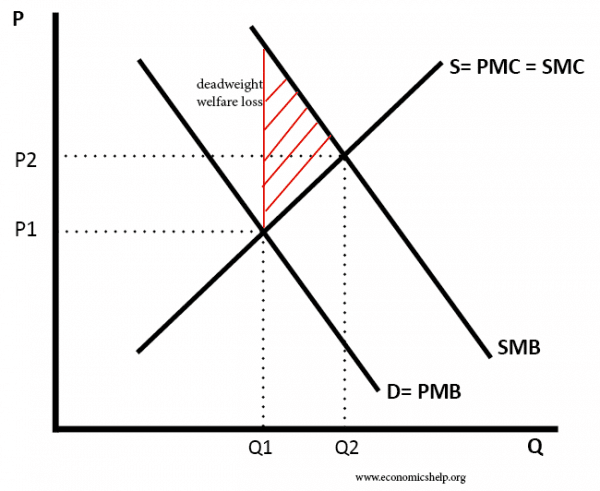Definition of social efficiency. This is the optimal distribution of resources in society, taking into account all external costs and benefits as well as the internal costs and benefits. Social efficiency occurs at an output where Marginal Social Benefit (MSB) = Marginal Social Cost (MSC).
Social efficiency is closely related to the concept of Pareto efficiency – A point where it is impossible to make anyone better off without making someone worse off
Note:
- Social benefit = private benefit + external benefit
- Social cost = private cost + external cost
Social efficiency and negative externality
We say social efficiency occurs at an output where Marginal Social Benefit (MSB) = Marginal Social Cost (MSC)
If a good has a negative externality – ignored by individuals, then in a free market, we tend to get over-consumption and social inefficiency.

In a free market, consumers ignore the external costs of consumption (e.g. you drive a car but don’t factor in the congestion you cause to other people). Therefore, the free market equilibrium is at Q1 (where S=D).
However, at Q1 the Marginal Social Cost is greater than the Marginal Social Benefit. Therefore by consuming at this point, the cost to society is greater than benefit (e.g. think of traffic jams and pollution because too many people drive at once). We say there is a deadweight welfare loss – indicated by the red triangle.
If the output is reduced from Q1 to Q2, society is in a better position. At Q2, the marginal social cost = the marginal social benefit. This is said to be socially efficient
Social efficiency and positive externality
With a positive externality, we ignore the benefits to third parties.
The free market equilibrium (Q1) is less than the socially efficient level (Q2) where SMC = SMB.
At Q1, the Marginal Social Benefit (MSB) is greater than the Marginal Social Cost (MSC). Therefore, in this situation, if we increase output from Q1 to Q2, the addition to social welfare (MSB) is greater than the marginal social cost, therefore net social welfare increases until we get to point Q1 where SMB = SMC.
Implications of Social efficiency
It is important to take into account externalities. (both positive and negative) It can be difficult to measure externalities, but we need to make an effort. Government intervention – taxes and subsidies can attempt to influence production and consumption to achieve social efficiency.
Related



your website is very helpfull i like it.
i also had difficulty in this concept but i get it now
Great short treatment, with useful links to related topics.
Yes, very helpful website. On the second graph, why is the red area still considered a “Dead Weight Loss” if there is a social welfare gain?
Thanks